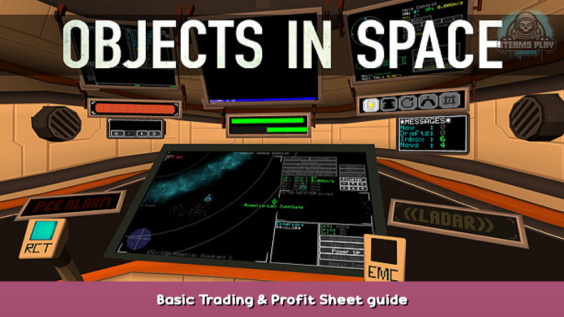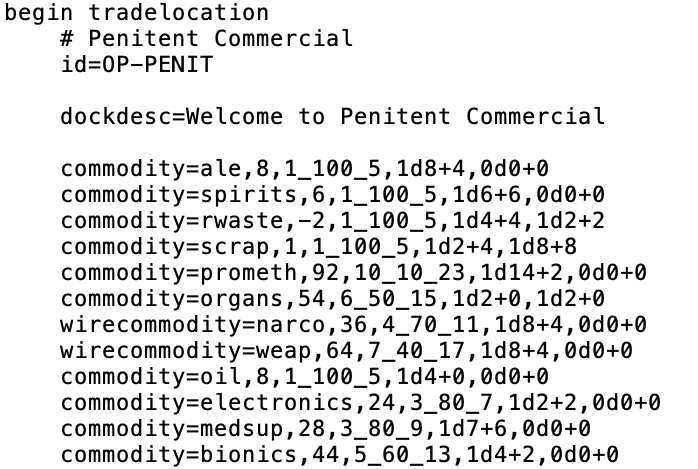
Fun and profit can be made by deciphering "trading_xxx.txt". Comment if you have any suggestions about the file contents!
Spreadsheet
For each station
This spreadsheet – Google.com – [google.com]
The station's expected price for each commodity and the amount it sells of each commodity are described. If there's no number next the commodity's price it means that the station hasn't sold that commodity. For example, if gold is what you want, look for stations with some stock. It should be low priced. When selling gold, you should look for stations that sell it at a high price.
The Files
Ok, so that's it. What We all know the stations. But How Do we know it all? What are we still learning? If this is something you are interested in, continue reading and leave a comment if there are any other ideas about what the files might mean.
This topic was first discussed in 2005.
This thread – http://steamcommunity.com – [steamcommunity.com]
. Many thanks to Dr_Bicinium & davecortesi for figuring out how commodity counts and prices are encoded. I found it, but I couldn’t find it so I wrote a Python program to convert the data into usable form.
My Python program – [google.com]
to do it. It also extracted a lot of data about contract-specific commodities that I manually removed because they aren't really part of dynamic economy.
Here's a look at what we have so far.
The trading data for each station are stored by the game in files named like "trading_leo.txt", grouped according to star system. They are stored in the same directory with most of the other game data. The format of the data for each tradable item at each stations is as follows:
"commodity=oxygen,2,1_100_5,1d3+3,1d2+2"
- The first part describes the commodity being described. Illegal items are called "wirecommodity", while the rest of this line is the same as for legal items.
- The predicted price of the item is the second half multiplied by 5. This can be seen when you talk with a station on the comms panel. This is what I believe acts as the item’s default price. The random amount is then added or subtracted to get the actual cost. The random amount is calculated each time you save a station or reload it. Sometimes the base amount the price fluctuates around can be different, such as when you sell more of an item than the station will allow. I'm not certain if the base number is determined from the station data or the actions of non-player Merchant Ships or any other market force.
- I don’t know what the third component means. Dr. Bicinium suggested that the middle number could be a multiplier or percentage, as it tends to be 100.
- We don't know what this fourth part means, but it is likely to be a roll of dice.
- The fifth part tells you how many of the item is available for purchase. It's a dice rolling, described in a format similar to some dice-based games like Dungeons & Dragons. "3d6+5" can be translated as "use a 6-sided, roll it three times, add 5 to the sum", meaning that the result can range from 8 to 23. "1d2+2", which can be 3 or 4, means that the result could be 3. The majority of items at each station have "0d0+0", meaning that they sell 0 (or don't sell) of that item.
If an item is in your cargo that a station happens to sell, its price will be close to the selling price, but usually at least 5c lower. Selling lots of an item to a station can decrease its demand for it, and thus lower the item's price. Because the buying and selling prices of an item are linked, the price at which you purchase it will be lower. It may make it profitable to purchase more of that item and then sell it at a station where it is more expensive.
If you sell a lot of one item at one station, the trading terminal shows how you will get less money each time you sell. (AKA diminishing return). Since increasing the station supply decreases the station's demand, you will get less money. This pattern was noted in the "Single Station Notes" sheet. The prices dropped at a steady rate of about 90% from the previous price. Every price required the same amount of items to lower it, except for the highest which required a different number. For example, sand could sell for 110c 4x, 100c 5x and 90c 5x. Then it would fall to 70c when there was only one unit left. Because of the conspicuous 90, I believe the third part of Adari's data line (the one that looks like "2_90_7") refers to this. But more experimentation might clarify this.
Here we come to an end for Objects in Space Basic Trading & Profit Sheet guide hope you enjoy it. If you think we forget something to include or we should make an update to the post let us know via comment, and we will fix it asap! Thanks and have a great day!
- Check All Objects in Space Posts List




Leave a Reply